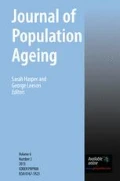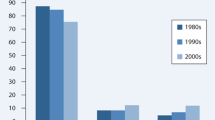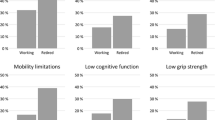Abstract
The paper argues that the existing literature, based on the Survey of Health, Ageing and Retirement in Europe (SHARE) data, on how working conditions impact on early retirement preferences/plans is hampered by the fact that the approach adopted to capture individuals’ early retirement plans fails to acknowledge that these preferences/plans are defined by reference to the rules that regulate the entitlement to pension benefits. In doing so, these studies risk overestimating the impact of working conditions on early retirement plans. We put forward a more accurate way of capturing individuals’ early retirement preferences/plans, which consists in using information on the age at which respondents plan to start collecting the basic pension benefits, and then computing whether the respondent plans to retire before the official age of retirement in his country of residence. Using SHARE microdata, wave 4, we show that individuals exposed to an imbalance between effort and rewards at work (Siegriest Journal Journal of Occupational Health Psychology, 1(1), 27–41, 1996 ) are more likely to plan to take-up early retirement. We also show that the effect of poor working conditions is smaller than one would find using the previous approach to the measurement of early retirement preferences/plans.
Similar content being viewed by others
Notes
This model was later extended to incorporate the level of (socio-emotional and instrumental) support that workers receive at work, which can act as a buffer to job demands. In line with this (extended) ‘demand-control-support’ model, jobs characterised by high demands, low control and low support – iso-strain jobs - would have the stringiest effect on individuals’ physical and psychological well-being (Karasek and Theorell 1990; Van Der Doef and Maes 1999).
Admittedly, Hurd and McGarry’s (1993) present several counter-intuitive results. For instance, the authors suggest that jobs that require bending or lots of physical effort have no significant statistical relation to workers’ expectations to be in work at ages 62 and 65. Not only that, their study suggests that jobs that don’t require any heavy lifting actually reduce the expected probability of working at ages 62 and 65.
See question EP036_, SHARE Generic Questionnaire (SHARE 2004: 52–3).
See question EP106_, SHARE Generic Questionnaire (SHARE 2004: 69).
In wave 4, the SHARE project surveys 58,489 individuals aged 50 and over in 16 European countries (Austria, Germany, Sweden, Netherlands, Spain, Italy, France, Denmark, Switzerland, Belgium, Czech Republic, Poland, Hungary, Portugal, Slovenia, Estonia) and Israel. Data was collected between 2010 and 2011. The survey covers a range of issues from income and assets, work and retirement, physical and mental health, care or social networks. It thus provides a powerful tool for comparative analysis ageing related issues.
We have excluded respondents from countries that have less than 30 observations in the dependent variable in the model, namely Denmark, Estonia and Poland. We also excluded respondents from Germany for which we only found 5 valid responses to questions EX007_ (expectation the Government will reduce pension benefits) and EX007_ (expectation the Government will reduce pension benefits), which then led to all respondents from this country being dropped from the model due to collinearity. We also excluded respondents from the Netherlands as, at the time the survey was conducted, the pension system did not allow for retirement before the ORA
Siegrist et al. (2006) show that individuals aged between 55 and 59 are more likely than those under 55 to plan for early retirement. However, this is not the case for individuals’ age between 60 and 65.
References
Becker, G. (1993). A treatise on the family. Harvard: Harvard University Press.
Blanchet D. & Debrand T. (2007). Souhaiter prendre sa retraite le plus tôt possible: santé, satisfaction au travail et facteurs monétaires. Économie et Statistique, 403, 39–62.
Blekesaune, M. & Solem, P. E. (2005). Working conditions and early retirement: A prospective study of retirement behavior. Research on Aging, 27(1), 3–30.
Bløndal, S., & Scarpetta, S. (1998). Retire early, stay at work? The OECD Observer, 212, 15.
Carr, E., Hagger-Johnson, G., Head, J., Shelton, N., Stafford, M., Stansfeld, S., & Zaninotto, P. (2016). Working conditions as predictors of retirement intentions and exit from paid employment: A 10-year follow-up of the English longitudinal study of ageing. European Journal of Ageing, 13, 39–48.
Chiricos, T., & Nestel, G. (1991). Occupational differences in the ability of men to delay retirement. The Journal of Human Resources, 26(1), 1–26.
Commission of the European Communities. (1999). Towards an Europe for All Ages - Promoting Prosperity and Intergenerational Solidarity, COM(1999) 221 final. Brussels: Commission of the European Communities http://ec.europa.eu/employment_social/social_situation/docs/com221_en.pdf. Accessed 30 Aug 2016.
Commission of the European Communities. (2005). Integrated guidelines for growth and jobs (2005–08). Brussels: Commission of the European Communities https://2007-2013.espa.gr/elibrary/integrated_guidelines_Growth_Jobs_en.pdf. Accessed 30 Aug 2016.
Dal Bianco, C., Trevisan, E., & Weber, G. (2015). “I want to break free”. The role of working conditions on retirement expectations and decision. European Journal of Ageing, 12, 17–28.
De Preter, H., Van Loory, D., & Mortelmans, D. (2013). Individual and institutional push and pull factors as predictors of retirement timing in Europe: A multilevel analysis. Journal of Aging Studies, 27, 299–307.
Debrand T. & Lengagne P. (2007). Pénibilité au travail et santé des seniors en Europe. Économie et Statistique, 403-404, 19–38.
Deschryvere, M. (2004). Health and retirement decisions: An update of the literature. The Research Institute of the Finnish Economy Discussion Papers, No. 9.
Ebbinghaus, B. (2006). Reforming early retirement in Europe, Japan and the USA. Oxford: Oxford University Press.
Ebbinghaus, B., & Hofäcker, D. (2013). Reversing early retirement in advanced welfare economies a paradigm shift to overcome push and pull factors. Comparative Population Studies, 38(4). http://www.comparativepopulationstudies.de/index.php/CPoS/article/view/138.
Economic Policy Committee and the European Commission (2006). The impact of ageing on public expenditure: projections for the EU25 Member States on pensions, health care, long-term care, education and unemployment transfers (2004–2050). Special Report No. 1/2006. Commission of the European Communities: Brussels. http://europa.eu/epc/pdf/ageingreport_en.pdf. Accessed 30 Aug 2016.
GØrtz, M. (2012). Early retirement in the day-care sector: The role of working conditions and health. European Journal of Ageing, 9, 187–198.
Gruber, J., & Wise, D. (1998). Social security and retirement: An international comparison. American Economic Review, 88(2), 158–163.
Hayward, M., Grady, W., Hardy, M., & Sommers, D. (1989). Occupational influences on retirement, disability, and death. Demography, 26(3), 393–409.
Hayward, M., Friedman, S., & Chen, H. (1998). Career trajectories and older men's retirement. Journal of Gerontology: Social Sciences., 53B(2), 91–103.
Hurd, M. & McGarry, K. (1993). The relationship between job characteristics and retirement. NBER Working Paper, No. 4558.
Ilmarinen, J., Tuomi, K., & Klockars, M. (1997). Changes in the work ability of active employees over an 11-year period. Scandinavian Journal of Work, Environment & Health, 23(suppl 1), 49–57.
Karasek, R. (1979). Job demands, job decision latitude, and mental strain: Implications for job redesign. Administrative Science Quarterly, 24(2), 285–308.
Karasek, R., & Theorell, T. (1990). Healthy work. Stress, productivity and the reconstruction of working Life. New York: Basic Books.
Karpansalo, M., Manninen, P., Lakka, T., Kauhanen, J., Rauramaa, R., & Salonen, J. (2002). Physical workload and risk of early retirement: Prospective population-based study among middle-aged men. Journal of Occupational and Environmental Medicine, 44(10), 930–939.
Kubicek, B., Korunka, C., Hoonakker, P., & Raymo, J. M. (2010). Work and family characteristics as predictors of early retirement in married men and women. Research on Aging, 32(4), 467–498.
Long, J., & Freese, J. (2006). Regression models for categorical dependent variables using STATA. Texas: STATA Press.
Mackenbach, J., Avendano, M., Andersen-Ranberg, K. & Aro, A. (2005). Physical Health. In A. Börsch-Supan, A. Brugiavini,, H. Jürges, J. Mackenbach, J. Siegrist W. and Weber (Eds.), Health, Ageing and Retirement in Europe. First Results from the Survey of Health, Ageing and Retirement in Europe (pp. 82–87). Mannheim: Mannheim Research Institute for the Economics of Aging (MEA). http://www.share-project.org/uploads/tx_sharepublications/SHARE_FirstResultsBookWave1.pdf. Accessed 30 Aug 2016.
Mein, G., Martikainen, P., Stansfeld, S., Brunner, E., Fuhrer, R., & Marmot, M. (2000). Predictors of early retirement in British civil servants. Age and Ageing, 29(6), 529–536.
O’Donnell, O., Van Doorslaer, E., Wagstaff, A., & Lindelow, M. (2008). Analyzing health equity using household survey data a guide to techniques and their implementation. Washington, D.C.: The World Bank.
Oakman, J., & Wells, Y. (2013). Retirement intentions: What is the role of push factors in predicting retirement intentions? Ageing and Society, 33(6), 1–21.
OECD. (2006). Work longer, live longer. Paris: OECD.
OECD (2011). Pensions at a glance 2011. Retirement-income systems in OECD and G20 countries. OECD Publishing. http://dx.doi.org/10.1787/pension_glance-2011-en. Accessed 30 Aug 2016.
OECD (2015). Pensions at a glance 2015. Retirement-income systems in OECD and G20 countries. OECD Publishing. http://www.oecd.org/publications/oecd-pensions-at-a-glance-19991363.htm. Accessed 30 Jan 2017.
Schnalzenberger, M., Schneeweis, N., Winter-Ebmer, R. & Zwemüller, M. (2008). Job quality and retirement decisions. In A. Börsch-Supan, A. Brugiavini, H. Jürges, J. Mackenbach, J. Siegrist and W. weber (Eds.) First results from the Survey of Health, Ageing and Retirement in Europe: Starting the Longitudinal Dimension (2004–2007) (pp. 215–221) Mannheim: Mannheim Research Institute for the Economics of Aging (MEA). http://www.share-project.org/fileadmin/pdf_documentation/FRB2/FRB2_all_chapters.pdf. Accessed 30 Aug 2016.
SHARE (2004). SHARE Generic Questionnaire, 1st Wave. http://www.share-project.org/data-access-documentation/questionnaires/questionnaire-wave-1.html Accessed 30 Aug 2016.
Siegriest, J. (1996). Adverse health effects of high-effort/low-reward conditions. Journal of Occupational Health Psychology, 1(1), 27–41.
Siegrist, J. & Wahrendorf, M. (2010). Quality of work, health and early retirement: European comparisons. Mannheim: Mannheim Research Institute for the Economics of Aging (MEA). http://mea.mpisoc.mpg.de/uploads/user_mea_discussionpapers/1121_224-10.pdf Accessed 30 Aug 2016.
Siegrist, J., Starkea, D., Chandola, T., Godinc, I., Marmot, M., Niedhammerd, I., & Peter, R. (2004). The measurement of effort–reward imbalance at work: European comparisons. Social Science & Medicine, 58, 1483–1499.
Siegrist, J., Wahrendorf, M., Von Dem Knesebeck, O., Jurges, H., & Borsch-Supan, A. (2006). Quality of work, well-being, and intended early retirement of older employees - baseline results from the SHARE study. European Journal of Public Health, 17(1), 62–68.
Solem, P. E. and Mykletun, R. (1997a). Work environment and early exit from work. In a. Kilbom, P. Westerholm, L. Hallsten, B. Furåker, B. (Eds.), Work after 45? Vol. II. Stockholm: National Institute for working Life.
Solem, P. E., & Mykletun, R. (1997b). Work environment and early exit from work. In A. Kilbom, P. Westerholm, L. Hallsten, & B. Furåke (Eds.), Work after 45? (pp. 285–292). Sweden: National Institute for Working Life.
SPC (2008). Promoting longer working lives through pension reforms. Second part. Early Exits from the labour market. Luxembourg: The Social Protection Committee.
Turcotte, M., & Schellenberg, G. (2005). Job strain and retirement. Perspectives on labour and income, 6(7), 13–17.
Van der Doef, M., & Maes, S. (1999). The job demand-control (−support) model and psychological well-being: A review of 20 years of empirical research. Work and Stress, 13, 87–114.
Wahrendorf, M., Dragano, N., & Siegrist, J. (2013). Social position, work stress, and retirement intentions: A study with older employees from the 11 European countries. European Sociological Review, 29(4), 792–802.
Williams, R. (2012). Using the margins command to estimate and interpret adjusted predictions and marginal effects. The Stata Journal, 12(2), 308–331.
Acknowledgements
This paper uses data from SHARE wave 4 release 1.1.1, as of March 28th 2013. The SHARE data collection has been primarily funded by the European Commission through the 5th Framework Programme (project QLK6-CT-2001-00360 in the thematic programme Quality of Life), through the 6th Framework Programme (projects SHARE-I3, RII-CT-2006-062193, COMPARE, CIT5- CT-2005-028857, and SHARELIFE, CIT4-CT-2006-028812) and through the 7th Framework Programme (SHARE-PREP, N° 211909, SHARE-LEAP, N° 227822 and SHARE M4, N° 261982). Additional funding from the U.S. National Institute on Aging (U01 AG09740-13S2, P01 AG005842, P01 AG08291, P30 AG12815, R21 AG025169, Y1-AG-4553-01, IAG BSR06-11 and OGHA 04-064) and the German Ministry of Education and Research as well as from various national sources is gratefully acknowledged (see www.share-project.org for a full list of funding institutions).
Author information
Authors and Affiliations
Corresponding author
Ethics declarations
Conflict of Interest
The authors declare that they have no conflict of interest.
Rights and permissions
About this article
Cite this article
Moreira, A., Azevedo, A.B. & Manso, L.P. Reducing Early Retirement in Europe: Do Working Conditions Matter?. Population Ageing 11, 265–284 (2018). https://doi.org/10.1007/s12062-017-9186-2
Received:
Accepted:
Published:
Issue Date:
DOI: https://doi.org/10.1007/s12062-017-9186-2




